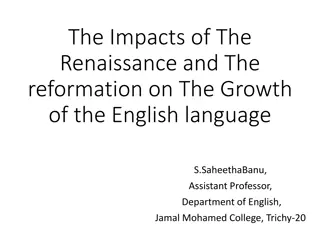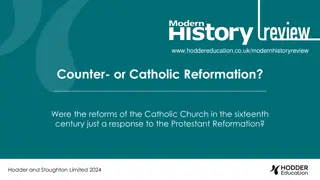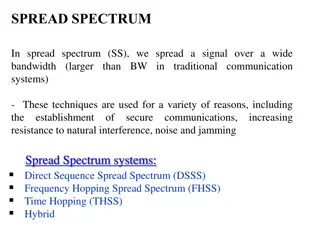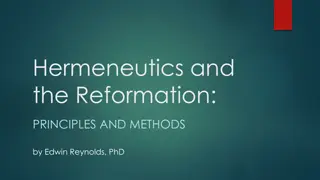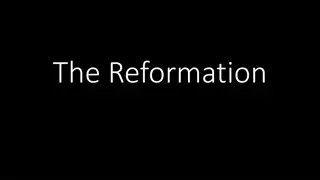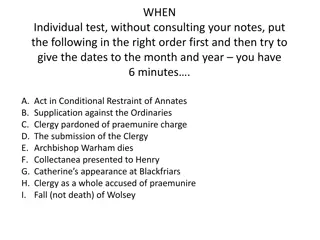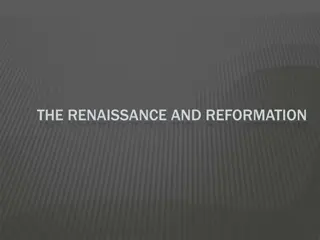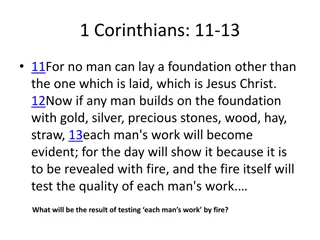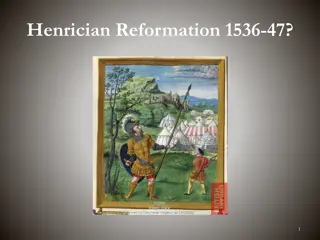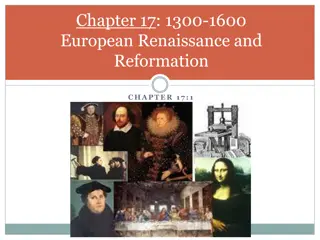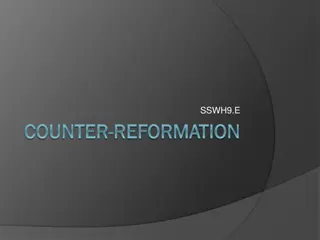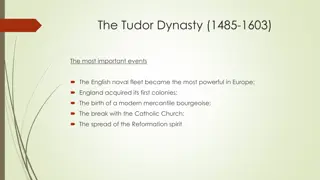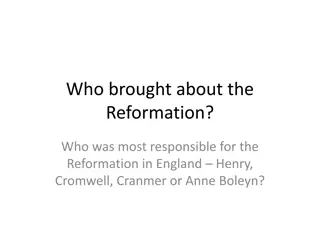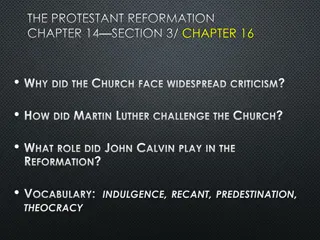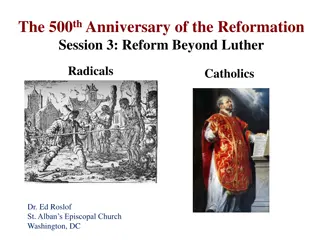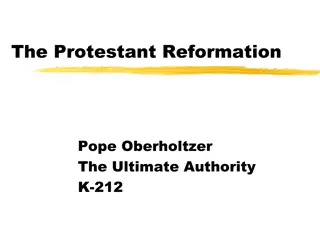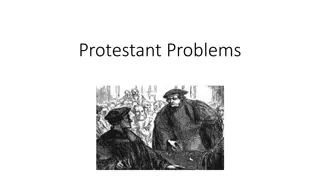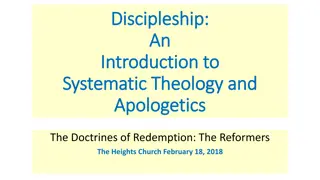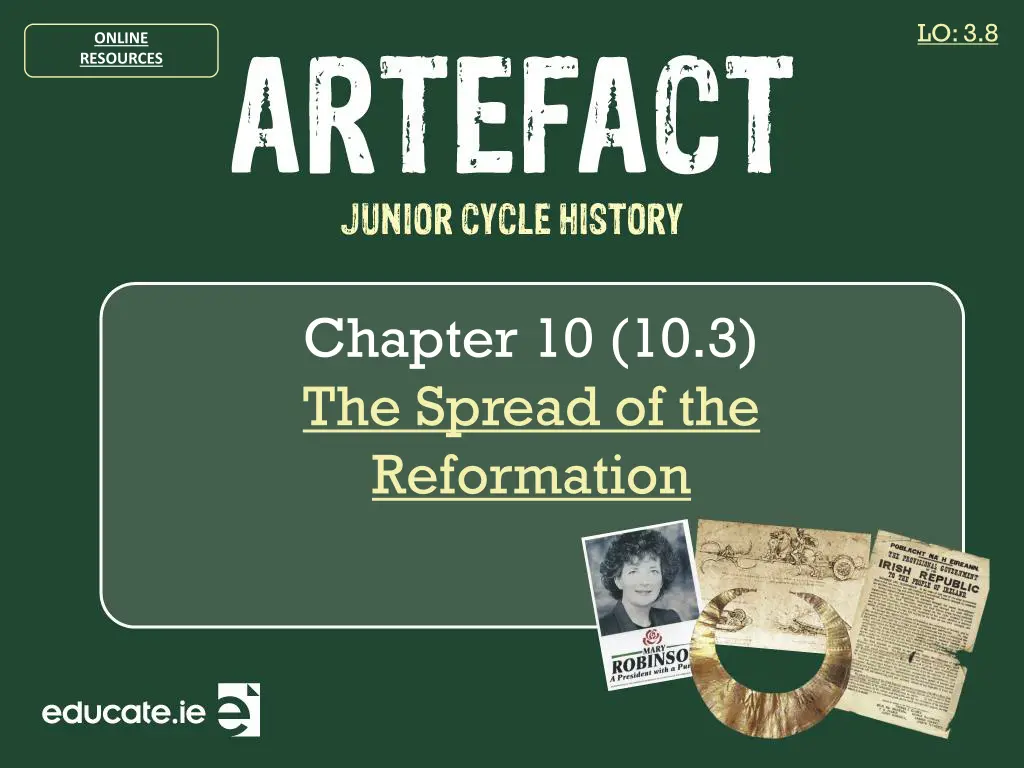
The Spread of the Reformation Across Europe
Explore how the Reformation rapidly spread across Europe, sparked by figures like Luther, Zwingli, and Calvin. Witness key events such as the establishment of new Protestant denominations and how religious divisions shaped Europe by 1600. Learn about the Catholic Church's response with the Counter-Reformation. Delve into a transformative period in European history that changed the religious landscape forever.
Download Presentation

Please find below an Image/Link to download the presentation.
The content on the website is provided AS IS for your information and personal use only. It may not be sold, licensed, or shared on other websites without obtaining consent from the author. If you encounter any issues during the download, it is possible that the publisher has removed the file from their server.
You are allowed to download the files provided on this website for personal or commercial use, subject to the condition that they are used lawfully. All files are the property of their respective owners.
The content on the website is provided AS IS for your information and personal use only. It may not be sold, licensed, or shared on other websites without obtaining consent from the author.
E N D
Presentation Transcript
LO: 3.8 ONLINE RESOURCES Chapter 10 (10.3) The Spread of the Reformation
The Spread of the Reformation Learning Intention(s) Understand how the Reformation spread throughout Europe.
THE SPREAD OF THE REFORMATION The Reformation spread quickly throughout Europe. After reading Luther s writings, many others began to question the teachings of the Catholic Church. Some came to broadly the same conclusions as Luther, but others would take a very different approach.
THE SPREAD OF THE REFORMATION The other major events in the Reformation were: 1531: Ulrich Zwingli launched the Reformation in Switzerland. 1534: Henry VIII established the Church of England as separate from the Catholic Church, with himself as head (you will learn more about this in chapter 11). 1537: King Christian III declared Lutheranism the official religion of Denmark and Norway.
THE SPREAD OF THE REFORMATION 1541: John Calvin was invited to Geneva, Switzerland to set up his version of Protestantism: Presbyterianism very different to both Lutheraniam and Catholicism. He believed in PREDESTINATION: that God had already decided who was going to heaven before people were born and nothing they did in life could affect that. He preached a strict Christianity that banned statues in churches, dancing, gambling, fancy clothes and anything else he thought might lead people into sin.
THE SPREAD OF THE REFORMATION 1571: The Netherlands became Protestant. 1572: John Knox introduced Presbyterianism to Scotland. Within a century of Luther publishing his theses, the Protestant challenge to the Catholic Church had spread across Europe. The continent divided along religious lines: most of the northern countries became Protestant and the south remained mostly Catholic.
THE SPREAD OF THE REFORMATION ` Religious divisions in Europe c.1600
THE SPREAD OF THE REFORMATION The Catholic Church launched the Counter- Reformation to slow or halt the growth of Protestantism.
Task Using page 141: Write about 3 ways in which the Reformation spread throughout Europe. Which major event on page 141 do you feel was the most significant? Explain your answer.
Presbyterianism was the Protestant church founded by Jean Calvin.
Predestination was the Presbyterian belief that God decided before a person was born whether they would go to heaven.
REVIEW QUESTIONS Name four European countries that became Protestant during the Reformation. Scotland, England, Netherlands, Denmark, Norway, Sweden, Switzerland, parts of France, Germany.
REVIEW QUESTIONS Explain the terms Presbyterianism and predestination. Presbyterianism: The Protestant church founded by Jean Calvin. Predestination: Calvin s belief that God had already selected those who would get into heaven.
REVIEW QUESTIONS Where did John Calvin set up his church? Geneva
REVIEW QUESTIONS Why do you think that southern Europe remained Catholic while northern Europe became Protestant? Southern Europe was closer to the power centre of the Catholic Church (Rome) and therefore it was easier for the Church to keep control over those areas.
ONLINE RESOURCES (Please note you will need to be online to access these resources) Khan Academy series on Reformation: https://educateplus.ie/go/reformation- introduction

